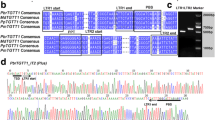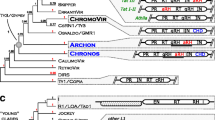Abstract
Plant LTR retrotransposons of the envelope class define a new branch in the Metaviridae family. They differ from other LTR retrotransposons mainly by the presence of an additional ORF downstream of the gag-pol region which has been hypothesized to be equivalent to the envelope gene of retroviruses. Here we present a newly identified element from pea (Pisum sativum), named PIGY, that has all the features characteristic of this group of LTR retrotransposons. In addition to the potential coding sequence downstream of the gag-pol region, PIGY has a primer binding site complementary to tRNAasp and a polypurine tract with a TGGGG motif and is of large size (13,645 bp). The relationship between PIGY and other retrotransposons of the env-class was confirmed by a phylogenetic analysis of their reverse transcriptase domains. One distinctive feature of PIGY is that its env-like region is actually composed of two similar ORFs, each of which encodes a protein with similarity to the Athila envelope-like protein. PIGY is present in the pea genome in 1–5×103 copies and is transcriptionally active, suggesting that some of these elements may still be capable of active transposition. Another new env-class retrotransposon similar to PIGY was also identified among genomic sequences of Medicago truncatula.






Similar content being viewed by others
References
Altschul SF, Madden TL, Schaffer AA, Zhang J, Zhang Z, Miller W, Lipman DJ (1997) Gapped BLAST and PSI-BLAST: a new generation of protein database search programs. Nucleic Acids Res 25:3389–3402
Arkhipova IR (2001) Transposable element in the animal kingdom. Mol Biol 35:157–167
Baranyi M, Greilhuber J (1996) Flow cytometric and Feulgen analysis of genome size variation in Pisum. Theor Appl Genet 92:297–307
Bennett MD, Smith JB (1976) Nuclear DNA amounts in angiosperms. Philos Trans R Soc Lond B Biol Sci 274:227–274
Bhattacharya S, Bakre A, Bhattacharya A (2002) Mobile genetic elements in protozoan parasites. J Genet 81:73–86
Boeke JD, Stoye JP (1997) Retrotransposons, endogenous retroviruses, and the evolution of retroelements. In: Coffin JM, Hughes SH, Varmus HE (eds) Retroviruses. Cold Spring Harbor Laboratory Press, Cold Spring Harbor, New York, pp 343–436
Chavanne F, Zhang DX, Liaud MF, Cerff R (1998) Structure and evolution of Cyclops: a novel giant retrotransposon of the Ty3/gypsy family highly amplified in pea and other legume species. Plant Mol Biol 37:363–375
Deininger PL, Batzer MA (2002) Mammalian retroelements. Genome Res 12:1455–1465
Dellaporta SL, Wood J, Hicks JB (1983) A plant DNA minipreparation: Version II. Plant Mol Biol Rep 1:19–21
Gualberti G, Doležel J, Macas J, Lucretti S (1996) Preparation of pea (Pisum sativum L.) chromosome and nucleus suspensions from single root tips. Theor Appl Genet 92:744–751
Havecker ER, Voytas DF (2003) The soybean retroelement SIRE1 uses stop-codon suppression to express its envelope-like protein. EMBO Rep 4:274–277
Hebsgaard SM, Korning PG, Tolstrup N, Engelbrecht J, Rouzé P, Brunak S (1996) Splice site prediction in Arabidopsis thaliana pre-mRNA by combining local and global sequence information. Nucleic Acids Res 24:3439–3452
Hirochika H, Hirochika R (1993) Ty1-copia group retrotransposons as ubiquitous components of plant genomes. Jpn J Genet 68:35–46
Hofmann K, Stoffel W (1993) TMBASE—a database of membrane spanning protein segments. Biol Chem Hoppe-Seyler 374:166
Hull R (2001) Classifying reverse transcribing elements: a proposal and a challenge to the ICTV. Arch Virol 146:2255–2261
Kim A, Terzian C, Santamaria P, Pélisson A, Prud’homme N, Bucheton A (1994) Retroviruses in invertebrates: the gypsy retrotransposon is apparently an infectious retrovirus of Drosophila melanogaster. Proc Natl Acad Sci USA 95:1285–1289
Krogh A, Larrson B, von Heijne G, Sonnhammer ELL (2001) Predicting transmembrane protein topology with a hidden Markov model: application to complete genomes. J Mol Biol 305:567–580
Kumekawa N, Ohtsubo E, Ohtsubo H (1999) Identification and phylogenetic analysis of gypsy-type retrotransposons in the plant kingdom. Genes Genet Syst 74:299–307
Laten HM (1999) Phylogenetic evidence for Ty1-copia-like endogenous retroviruses in plant genomes. Genetica 107:87–93
Laten HM, Majumdar A, Gaucher EA (1998) SIRE-1, a copia/Ty1-like retroelement from soybean, encodes a retroviral envelope like protein. Proc Natl Acad Sci USA 95:6897–6902
Leitch AR, Schwarzacher T, Jackson D, Leitch IJ (1994) In situ hybridization. BIOS Scientific Publishers Ltd, Oxford
Lerat E, Capy E (1999) Retrotransposons and retroviruses: analysis of the envelope gene. Mol Biol Evol 16:1198–1207
Lowe TM, Eddy SR (1997) tRNAscan-SE: a program for improved detection of transfer RNA genes in genomic sequence. Nucleic Acids Res 25:955–964
Malik HS, Eickbush TH (1999) Modular evolution of the integrase domain in the Ty3/Gypsy class of LTR retrotransposons. J Virol 73:5186–5190
Malik HS, Eickbush TH (2001) Phylogenetic analysis of ribonuclease H domains suggests a late, chimeric origin of LTR retrotransposable elements and retroviruses. Genome Res 11:1187–1197
Malik HS, Henikoff S, Eickbush TH (2000) Poised for contagion: evolutionary origins of the infectious abilities of invertebrate retroviruses. Genome Res 10:1307–1318
Marchler-Bauer A et al (2003) CDD: a curated Entrez database of conserved domain alignments. Nucleic Acids Res 31:383–387
Neumann P, Nouzová M, Macas J (2001) Molecular and cytogenetic analysis of repetitive DNA in pea (Pisum sativum L). Genome 44:716–728
Neumann P, Požárková D, Macas J (2003) Highly abundant pea LTR retrotransposon Ogre is constitutively transcribed and partially spliced. Plant Mol Biol 53:399–410
Pearson WR, Lipman DJ (1988) Improved tools for biological sequence comparison. Proc Natl Acad Sci USA 85:2444–2448
Peterson-Burch BD, Voytas DF (2002) Genes of the Pseudoviridae (Ty1/copia retrotransposons). Mol Biol Evol 19:1832–1845
Peterson-Burch BD, Wright DA, Laten HM, Voytas DF (2000) Retroviruses in plants? Trends Genet 16:151–152
Rabson AB, Graves BJ (1997) Synthesis, assembly, and processing of viral proteins. In: Coffin JM, Hughes SH, Varmus HE (eds) Retroviruses. Cold Spring Harbor Laboratory Press, Cold Spring Harbor, New York, pp 263–334
Schmidt T (1999) LINEs, SINEs and repetitive DNA: non-LTR retrotransposons in plant genomes. Plant Mol Biol 40:903–910
Song SU, Gerasimova T, Kurkulos M, Boeke JD, Corces VG (1994) An env-like protein encoded by a Drosophila retroelement: evidence that gypsy is an infectious retrovirus. Genes Dev 8:2046–2057
Sonnhammer ELL, Durbin R (1995) A dot-matrix program with dynamic threshold control suited for genomic DNA and protein sequence analysis. Gene 167:GC1–GC10
Staden R (1996) The Staden sequence analysis package. Mol Biotechnol 5:233–241
Suoniemi A, Tanskanen J, Schulman AH (1998) Gypsy-like retrotransposons are widespread in the plant kingdom. Plant J 13:699–705
Swanstrom R, Wills JW (1997) Synthesis, assembly, and processing of viral proteins. In: Coffin JM, Hughes SH, Varmus HE (eds) Retroviruses. Cold Spring Harbor Laboratory Press, Cold Spring Harbor, New York, pp 263–334
Thompson JD, Higgins DG, Gibson TJ (1994) CLUSTAL W: improving the sensitivity of progressive multiple sequence alignment through sequence weighting, position-specific gap penalties and weight matrix choice. Nucleic Acids Res 22:4673–4680
Vicient CM, Kalendar R, Schulman AH (2001) Envelope class retrovirus-like elements are widespread, transcribed and spliced, and insertionally polymorphic in plants. Genome Res 11:2041–2049
Vogt VM (1997) Retroviral virions and genomes. In: Coffin JM, Hughes SH, Varmus HE (eds) Retroviruses. Cold Spring Harbor Laboratory Press, Cold Spring Harbor, New York, pp 27–70
Wilhelm M, Wilhelm F-X (2001) Reverse transcription of retroviruses and LTR retrotransposons. Cell Mol Life Sci 58:1246–1262
Wöstemeyer J, Kreibich A (2002) Repetitive DNA elements in fungi (Mycota): impact on genomic architecture and evolution. Curr Genet 41:189–198
Wright DA, Voytas DF (2001) Athila4 of Arabidopsis and Calypso of soybean define a lineage of endogenous plant retroviruses. Genome Res 12:122–131
Xiong Y, Eickbush TH (1990) Origin and evolution of retroelements based upon their reverse transcriptase sequences. EMBO J 9:3353–3362
Acknowledgements
We thank Ms. H. Štěpančíková for excellent technical assistance, Dr. M. Nouzová for help with DNA sequencing, and Ms. S. M. Rafelski for assistance in preparation of the manuscript. This work was supported by grants (Nos. 521/00/0655 and 521/02/P007) from the Grant Agency of the Czech Republic
Author information
Authors and Affiliations
Corresponding author
Additional information
Communicated by M.-A. Grandbastien
Rights and permissions
About this article
Cite this article
Neumann, P., Požárková, D., Koblížková, A. et al. PIGY, a new plant envelope-class LTR retrotransposon. Mol Genet Genomics 273, 43–53 (2005). https://doi.org/10.1007/s00438-004-1092-7
Received:
Accepted:
Published:
Issue Date:
DOI: https://doi.org/10.1007/s00438-004-1092-7




